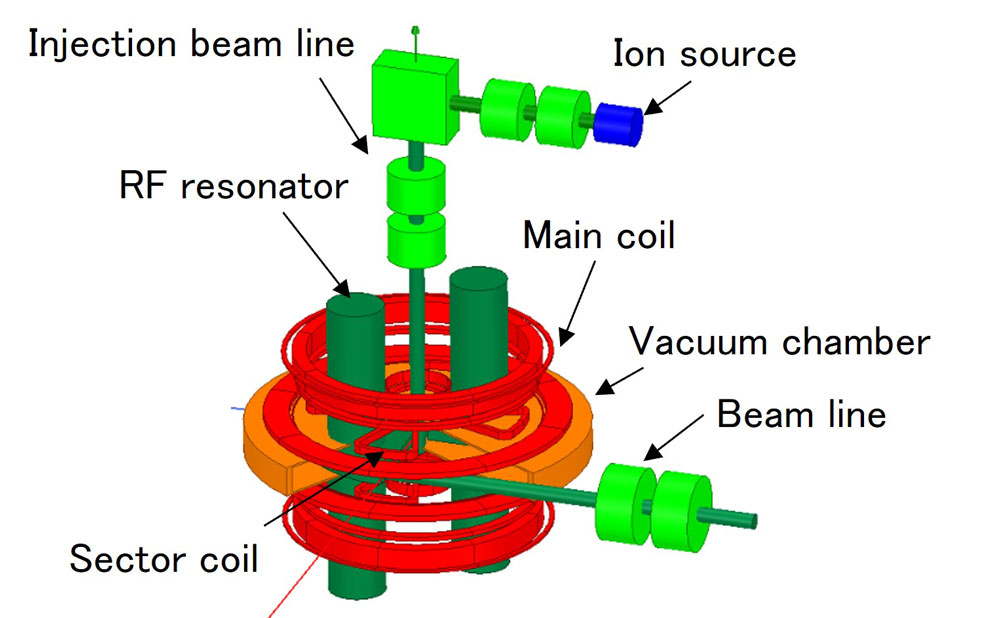AP-1-3-INV
Application of high-temperature superconductor to cyclotrons
11:00-11:30 28/11/2023
*Mitsuhiro Fukuda1, Tetsuhiko Yorita1, Hiroki Kanda1, Yusuke Yasuda1, Tsun Him Chong1, Shotaro Matsui1, Shigeo Nagaya1, Takafumi Hara1, Zhao Hang1, Masaki Kittaka1, Kaoru Watanabe1, Tomoki Imura1, Hui Wen Koay2, Atsushi Ishiyama3, So Noguchi4, Hiroshi Ueda5, Satoshi Fukui6, Masao Nakao7, Tomonori Watanabe8, Jun Yoshida9, Takashi Hirayama9, Yukio Mikami9, Yuji Matsubara9, Keijiro Takeda9, Takashi Kitamura0
1. Research Center for Nuclear Physics, Osaka University, 10-1 Mihogaoka, Ibaraki, Osaka 567-0047, Japan
2. TRIUMF, 4004 Wesbrook Mall, Vancouver, BC V6T 2A3, Canada
3. Waseda University, 3-4-1 Okubo, Shinjuku-ku, Tokyo 169-8555, Japan
4. Hokkaido University, Kita 14, Nishi 9, Kita-ku, Sapporo, Hokkaido, 060-0814, Japan
5. Okayama University, 3-1-1 Tsushima-naka, Kita-ku, Okayama 700-8530 Japan
6. Niigata University, 8050 Ikarashi 2-no-cho, Nishi-ku, Niigata 950-2181, Japan
7. Gunma University, 3-39-22 Showa-machi, Maebashi City, Gunma 371-8511, Japan
8. Chubu Electric Power Co., Inc., 20-1 Kitasekiyama, Oodakacho, Midoriku, Nagoya 459-8001, Japan
9. Sumitomo Heavy Industries, Ltd., 19 Natsushimacho, Yokosuka, Kanagawa 237-0061, Japan
0. Hagoromo Electric, Inc., 7-231 Ootorinakamachi, Nishiku, Sakai, Osaka 593-8327, Japan
A superconducting coil is now widely used for accelerator magnets to increase a magnetic field to higher than 2 T and to decrease a magnet size for compactness of an accelerator. The world’s first superconducting cyclotron was developed at Michigan State University in 1981. Since then, a low-temperature superconducting cyclotron has become widespread especially for proton therapy. In recent years, a high-temperature superconducting coil using BSCCO (Bismuth Strontium Calcium Oxide) superconductor was developed for a dipole magnet and a solenoid lens. High-temperature superconductor has the great advantage in stability and reliability of a superconducting magnet. A new compact high-temperature superconducting particle accelerator named “skeleton cyclotron” [1], using REBCO (Rare-Earth Barium Copper Oxide) superconductor, has been designed to provide a high intensity ion beam for mass production of short-lived radioisotopes and for development of an intense neutron source. Several skeleton cyclotron models are made to fulfill the requirements for various kinds of interdisciplinary applications. One of the innovative models is complete air-core magnet type, consisting of several circular-shape main coils and triangular-shape sector coils using REBCO tapes. The maximum averaged magnetic field at an extraction radius of 50 cm is 2.5 T. A conceptual diagram of the skeleton cyclotron of air-core type is shown in Fig. 1. The other model is self-shielded type with thick return yokes made of iron to reduce a fast neutron flux from the inside of the cyclotron and to decrease the stray magnetic field generated by the air-core coils. Physical design of a more compact skeleton cyclotron with an extraction radius of 40 cm was almost completed [2]. An axial focusing force for accelerated particles is obtained from the flutter generated by a set of triangle-shaped sector coils. One of the most significant issues for the combination of high-temperature superconducting air-core coils is deterioration of the critical current caused by the perpendicular component of the magnetic field on REBCO tapes. Recently we have developed a prototype of circular-shape and racetrack-shape REBCO coils with a smaller size than the skeleton cyclotron magnet to test the performance of the REBCO coils at 77 K under the circumstance of the perpendicular magnetic field component. The coil assembly was designed to use for an ECR ion source using 2.45 and 10 GHz microwaves [3].
A low-temperature superconducting RF cavity has been developed for a high energy linear accelerator at many accelerator facilities and exhibited its superior performance so far. A superconducting RF cavity for a cyclotron has not been realized yet due to the difficulty in establishment of superconductivity in the cyclotron circumstance. We have started feasibility study of designing a high-temperature superconducting RF cavity for a ring cyclotron. Key issues for realization of the specific cavity are shaping it into a rectangular cavity, enlarging the cavity size to several meters and decreasing the stray magnetic field to less than 22 mT at 20 K in the cavity area. We have investigated practical conditions to satisfy the requirements for the high-temperature superconducting RF cavity and the cyclotron magnet.
[1] H. Ueda, M. Fukuda, K. Hatanaka, T. Wang, X. Wang, A. Ishiyama, S. Noguchi, S. Nagaya, N. Kashima, N. Miyahara, “Conceptual Design of Next Generation HTS Cyclotron,” IEEE Trans. Appl. Supercond., Vol..21, p.4100205(2013)
[2] H.W. Koay, M. Fukuda, H. Kanda, T. Yorita, "Beam Dynamics and Characterization of a New High-intensity Compact Air-core High Temperature Superconducting Skeleton Cyclotron (HTS-SC)," Results in Physics, 33 (2022) 105090
[3] T H Chong, M Fukuda, T Yorita, H Kanda, Y Yasuda, H W Koay, Y Morita, K Takeda, T Hara, M Hisamatsu, H Zhao, A. Ishiyama, S Noguchi, H Ueda, S Fukui, Y Matsubara, Y Mikami, N Takahashi, J Yoshida, T Hirayama, S Nagaya and T Watanabe, “Development of ECR ion source with high-temperature superconducting REBCO coils,” Journal of Physics: Conference Series, 2244 (2022) 012108, doi:10.1088/1742-6596/2244/1/012108
This research was supported by Program on Open Innovation Platform with Enterprises, Research Institute and Academia, Japan Science and Technology Agency (JST, OPERA, JPMJOP1721).
